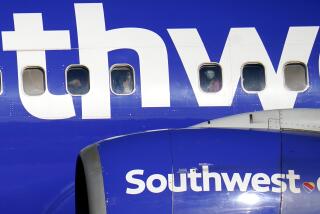A User’s Guide to Airline Lavatories
NEW YORK — It’s a traveler’s nightmare. The flight home from Mexico has one lavatory for every 90 passengers. You’re No. 89 in line, and that last burrito isn’t sitting well.
Don’t blame Boeing or McDonnell Douglas. As with seat layout, it’s the airline, not the airplane manufacturer, that specifies the number of lavatories on any given plane.
“Airlines select their own interiors,” said Brian Ames, a spokesman for Boeing Co. “Lavatory numbers and locations are a part of that.”
But even Ames was surprised at how widely the passengers-to-toilet ratio can vary from one carrier to another.
A survey by Consumer Reports Travel Letter found that in economy class, some planes allocate one toilet per 19 passengers (Japan Airlines 747), while others have only one for each 100 travelers (USAir and United 737s).
“I’ll be darned,” Ames said. “That’s a little amazing.”
On average, the survey found the number of passengers per lavatory was 46 in coach/economy, 20 in business class and 11 in first class.
“Our research shows that it’s not a big problem or people would start complaining,” said Tony Molinary, a spokesman for United.
*
Accessible restrooms are an issue for pregnant women, for men who have prostate problems, for people with young children, and for anyone coming back from a vacation where they’ve picked up an unwelcome bug.
“Try taking a 14-hour flight to England with two kids on a plane with not enough restrooms,” traveler M. Snyder said on an online forum. “Suddenly, it does get really important.”
Obviously, planes don’t fly at full capacity all of the time. But recently, they’ve been flying about 70% full, which can mean a long line for the loo.
“Consider a line of five people . . . with some taking three to five minutes or more to do their thing,” said frequent traveler Gary Bellaire of Houston. “My bladder is not industrial-strength.”
For children, the issue isn’t just the wait, it’s where to wait, said Jessica Greenbaum, a New York-based writer who flew 28 hours to Sri Lanka last fall with a 2 1/2-year-old.
“Fifteen minutes for a kid with a dirty diaper is not going to please the people [nearby],” she said.
Planes used mainly for longer flights had better potty parity than those used for short flights. For example, the survey found that Boeing 747s--used primarily for lengthy trips--had an average ratio in the economy section of 38 people per toilet.
The most widely used short-haul plane, the Boeing 737, had an average of 63 passengers per privy.
Some travelers have complained that the Boeing 757s tend to be especially low on lavatories. The survey found that the aircraft had an average ratio of 61 passengers per lavatory--not bad for a short flight, but the 757 is often used for longer international flights.
*
Consumer Reports evaluated most planes using a seating diagram published in the Official Airline Guides, Carlson’s Airline Guides or Carlson’s Seating Guide.
As expected, the best bathroom ratio was in the business and first-class sections.
“I think that the overall picture you get is one that mirrors the rest of the airlines’ philosophy,” Travel Letter editor Ed Perkins said. “They pamper the people up front and sort of thumb their nose at the people in the back.”
A business class passenger on an Aeromexico 767 might find only five people per privy, but that was more the exception than the rule. Most business class ratios fell into the double-digits, and the South African Airways Airbus 300 had 65 people per lavatory in business class.
And even flying first class doesn’t guarantee a good seat--so to speak. Some first-class sections don’t have their own lavatory. Among those that do, the ratio can be as generous as four passengers per lavatory (Northwest 747), or as stingy as the Air France and British Airways Concordes, which had the worst ratio for any first class. With one lavatory per 33 people, it’s a good thing they fly so fast.
*
Molinary said a lot of thought goes into juggling the johns when a plane’s interior is chosen.
“Space means everything. How big the lavatories are, how many there are, and exactly where they’re located,” he said. “It’s very important.”
Sometimes, the design of the plane is limiting, Molinary said. With the 757, for instance, a long, narrow design restricts potty placement.
Bellaire, who takes about 50 trips a year, noted that where a person sits can make a bad situation seem worse.
“People sitting in the front have to wait for the food cart to go by” before they can get up and go, he said. “By the time that happens, then the cart starts going the other way. It’s kind of a double whammy.”
And Greenbaum noted that the size of airplane bathrooms makes diaper changing next to impossible.
“Airplanes aren’t luxury vessels,” she said. “On the other hand, there should be some middle ground.”
*
There’s some more bad news. Many airlines have more than one version of a given airplane model, and they may be outfitted differently. For passengers, there’s no way to determine in advance which layout will be used for any given flight.
Overall, some of the stingiest planes for people flying economy were 737s as outfitted by USAir (one lavatory per 102 passengers); United (101), Delta (95) and Continental (90).
Also near the bottom of the bowl were DC9s outfitted by Aeromexico and Continental (90), Air Canada (80), and, among 757s, Delta (82) and Continental (78 to 80).
Bellaire said he copes by heading to the lavatory as soon as possible after takeoff--just as a preventive measure--to beat later lines and to avoid that inevitable moment when the captain turns on the seat-belt sign mid-flight.
Lynn Williams of Key West, Fla., has another solution.
“I just turn around and go to the lavatory in business or first class and ignore the stewardesses,” he said. “But the average passenger won’t do that.”
More to Read
Sign up for The Wild
We’ll help you find the best places to hike, bike and run, as well as the perfect silent spots for meditation and yoga.
You may occasionally receive promotional content from the Los Angeles Times.






